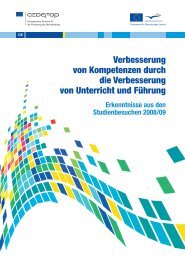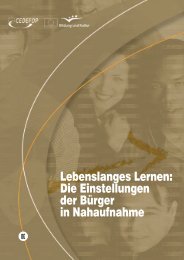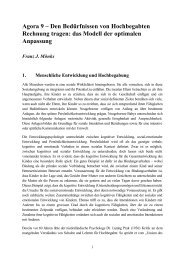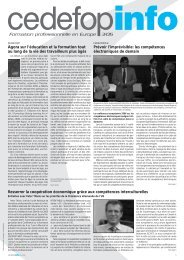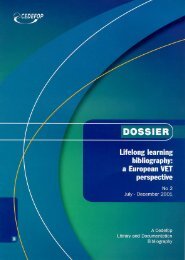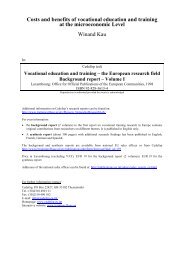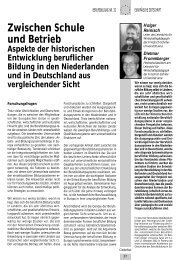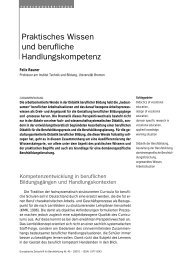Full text (pdf) - Cedefop - Europa
Full text (pdf) - Cedefop - Europa
Full text (pdf) - Cedefop - Europa
You also want an ePaper? Increase the reach of your titles
YUMPU automatically turns print PDFs into web optimized ePapers that Google loves.
192<br />
European journal of vocational training<br />
No 42/43 – 2007/3 2008/1<br />
Differences between ECVET and ECTS derive from the fact that the former,<br />
unlike the latter, does not have many years of experience behind it. ECTS<br />
was first introduced in 1989 in the con<strong>text</strong> of the ERASMUS European mobility<br />
programme, while the first meeting of the European technical group on<br />
the development of a credit system for VET in Europe was held only in late<br />
2003. Mutual trust and understanding among universities themselves and with<br />
other tertiary-level institutions grew during that period. Non-governmental organisations<br />
(NGOs) such as the European University Association (EUA) and<br />
the European Association of Institutes in Higher Education (EURASHE) pursued<br />
common aims. At European level, furthermore, the Council of Europe,<br />
the European Students’ Union (ESIB) and UNESCO’s European Centre for<br />
Higher Education (UNESCO - CEPES) are involved as observers. The Bologna<br />
Process provides a framework for the introduction of a system of easily understandable<br />
and comparable higher education diplomas in all participating<br />
countries. The Bologna member countries have committed themselves to the<br />
process itself and exercise self control over the implementation of the Bologna<br />
priorities by means of stocktaking activities and follow-up groups.<br />
In VET, there is so far no common procedure and no NGO operating in<br />
the field. It is more difficult to develop a credit system for VET because, for<br />
example, in some countries, the holders of certain diplomas issued by VET<br />
colleges are awarded qualifications at levels typically achieved by university<br />
graduates at bachelor level in other countries. The advantage of ECTS<br />
over ECVET is that readily comparable institutional and curricular conditions<br />
and courses (including the time input) apparently make it easier to find a<br />
benchmark for learning outcomes in relation to study disciplines and curricula.<br />
The VET sector, by contrast, comprises a large number and variety<br />
of institutions, traditions, statutory regulations and forms of social recognition<br />
in each individual Member State. ECTS, in fact, says nothing about the<br />
content, composition or equivalence of study programmes. It has much more<br />
to do with quality issues, which universities must settle by means of bilateral<br />
or multilateral cooperation agreements. The starting-point for ECVET<br />
qualifications, on the other hand, is technical specifications (e.g. for knowledge<br />
and skills) and quality assurance procedures, as well as the assessment<br />
and validation of outcomes. In practical terms, ECVET is based on the<br />
one hand on the description of qualifications in the form of learning outcomes<br />
or knowledge, skills and competences and, on the other, on the award of<br />
credits for qualifications and units or modules. Credits will be discussed in<br />
the next section. Learning outcomes (see Table 3) are the main common<br />
element of ECVET, ECTS and EQF. However, the ‘learning outcomes’ for




